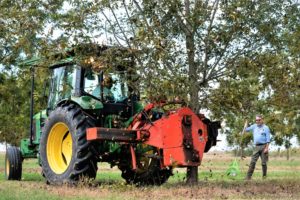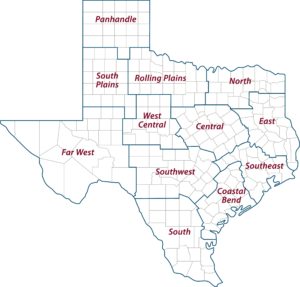Texas pecan production below average, demand remains strong
Texas Crop and Weather Report – Sept. 20, 2022
Texas pecan orchards were expected to produce a mixed bag of results amid good prices and strong demand, according to a Texas A&M AgriLife Extension Service expert.

Larry Stein, Ph.D., AgriLife Extension horticulturist, Uvalde, said the drought and heat likely impacted some orchards, and 2022 was expected to be a below-average year also because last year’s crop was heavy.
Pecan trees typically go through cyclical performance year to year. Heavy crops are typically followed by lighter yields and vice versa.
Stein said harvest for early varieties like Pawnee will begin this week, but most of the other later varieties will be harvested in October. Pecan orchards in the Far West were showing good crop loads while trees in Central Texas were expected to provide below-average yields.
“The crop looks good, but it is hit and miss this year,” Stein said. “If you want pecans, I would suggest finding them early to make sure you get some.”
Texas pecan prices good, domestic demand up
Drought will likely mean smaller pecan size, but Stein said that is not necessarily a bad thing because kernels fill out easier. He said the widespread rainfall should help most pecans, but moisture in the form of rainfall or irrigation will be needed to help kernels fill over the next few weeks.
Most commercial producers have irrigation, which is an important factor for producing retail-quality pecans. The moisture will help trees finish the crop, but it will also keep the tree healthy and help it store food for next year’s pecan crop. Stein recommends 2 inches of water at and beyond the drip line per week through harvest.

“Drought was stressful on the trees, but the producers who were able to keep up on irrigation should be fine,” he said. “They’ll continue to irrigate to finish the crop.”
Blair Krebs, Texas Pecan Growers Association executive director, said the pecan crop suffered through the extreme heat and drought, but producers with a decent crop should do well this season.
Very early retail quality Pawnee pecans were selling between $2.40 to $2.75 per pound in the shell, she said. Prices in recent years have been between $2 to $3 per pound for in-shell pecans and around $4 for shelled pecans.
Krebs said domestic demand for pecans was stronger this year, and export demand from other countries, including Mexico, South Africa and South American nations, has filled the gap the trade war with China created for U.S. pecan growers.
Yellow aphids a sticky situation
Trees in commercial orchards have been relatively clean of pests all year due to the dry conditions. But one pest – yellow aphids – are making their presence known, especially in homeowner trees, Stein said.
Stein said he has seen reports and received calls about yellow aphids more than usual this year. Yellow aphids are to blame for the sappy excretion homeowners may have noticed if they park under pecan trees. Yellow aphids feed on leaves and expel the liquid. Infestations do not typically harm trees, and aphid populations usually crash without treatment.
The emergence of yellow aphids is later than usual this year, likely due to extended drought, but their numbers appear to be heavier than normal across the state, he said.
“They’re cyclical and will go away but seem to have come out of the woodwork after the last few weeks of rain,” he said. “We typically tell people to leave them alone because we think the damage to trees is minimal and sprays can actually make things worse.”
AgriLife Extension district reporters compiled the following summaries:
CENTRAL
Conditions were dry and warmer than normal. Soil moisture remained very short in nearly all counties. More rain was needed to support new growth in pastures. Weeds, especially Johnson grass, were prevalent in pastures. Peanut yields looked good. Cotton yields were on the poor side. Aphid flareups in pecans made spraying necessary in many orchards. Beef cattle numbers were low due to recent culls. Supplemental feeding for cattle continued. Some producers were getting in another cutting of hay. Stock tanks were dry.
ROLLING PLAINS
Topsoil dried down following recent rains. Overall, conditions were still dry and pasture conditions worsened. Winter wheat plantings were picking up, with a small portion of early planted fields emerged. Some dry-planted wheat may not emerge without rain, and weeds were becoming an issue. Cotton yields were still uncertain, but most remaining fields were not progressing like usual. Pastures and hayfields did well for a few weeks following widespread rain. A decent number of bales were produced with one more cutting of hay expected, but yields were likely to be low. Hay supplies were expected to remain tight. Armyworms were a problem in some areas, and producers were spraying pastures.
COASTAL BEND
Dry weather gave many farmers a chance to harvest remaining cotton and soybean fields, but some areas were still too wet to work in fields. Many fields had volunteer plant growth, and producers used planes to spray. Land preparation for wheat, oats and rye grass was expected to begin soon. Some hay was being harvested in areas that received adequate rainfall, and yields were fair. Armyworms continued to be a problem in pastures. Rangeland and pasture conditions were excellent in most areas. Livestock body conditions continued to improve with plenty of quality forage available. Cattle producers were weaning calves.
EAST
Conditions were drying out following relief from rain, with pasture and rangeland conditions from fair to good. Subsoil and topsoil conditions were adequate. Producers were cutting and baling hay as quickly as possible to try and beat the armyworms. There were many reports of armyworm infestations. Hay supplies remained short. Producers continued culling their herds. Livestock were in fair to good condition with some supplemental feeding taking place. Wild pig control was underway in Gregg County.
SOUTH PLAINS
Pasture conditions improved following the rainfall received earlier in the month. Dryland cotton was poor but irrigated fields looked fair. Cotton farmers were waiting for bolls to continue opening. The ground was saturated in some areas, and some fields still had standing water. Everything was green and growing in pastures. The wholesale pumpkin harvest began several weeks ago. Early yields on the pumpkin crop varied from producer to producer, with some estimating a 20% drop from last year and others seeing higher yields than last year. Pumpkin harvest for the retail sector started recently. Sorghum was maturing and getting closer to harvest. Cattle were in good condition.
PANHANDLE
Conditions turned dry over the past week, but soil moisture content remained short to adequate. Rangeland and pastures were in poor to good condition. Cotton yields were expected to be below average in dryland acres, but irrigated cotton was in good to excellent shape. Several irrigated farmers were forced to shut off wells over recent weeks due to a lack of water, but rains helped some. Peanuts were in good condition and nearing maturity. Livestock were in good condition with plenty of grazing. Some producers were planting wheat for grazing. More rainfall will be needed soon to help winter wheat emerge and establish good stands. Some producers were harvesting corn and sorghum silage.
NORTH
Soil moisture throughout the district was short to adequate with no rain reported. Temperatures reached the mid-90s for the week. Warmer temperatures and wind were starting to dry the topsoil. Summer grasses were still growing well after the rains. Hay production picked up but was expected to slow soon without rain. A few areas should get another cutting of hay. Grasshoppers and sugarcane aphid numbers were high.
FAR WEST
Temperatures were higher with less cloud cover. The average high and low temperatures were 86 degrees and 65 degrees, respectively. Some isolated showers were received with some areas receiving more than a half inch. Hay grazer emerged and made a good stand but was beginning to show some stress. Hay grazer planted after the rain had not made a good stand and was beginning to die off. Cotton bolls were opening rapidly and looked great with other fields continuing to bloom. A few fields will be ready to pick within a week or two. Most producers were not in a hurry since modules will have to wait at gins for a larger percentage of the crop to be harvested to minimize gin operation runtime and prevent shutdowns. Producers were preparing for the beginning of pumpkin season. Pecans were doing well. Harvest was nearing and producers were busy preparing orchard floors for shaking trees. Pastures were almost bare again due to overgrazing. Bucks and rams will soon be put out for breeding. Livestock were still being sold due to drought conditions. Heavy rainfall was reported in western rangelands. The Rio Grande River was outside its banks due to heavy runoff from the watershed. Pima and Upland cotton around El Paso looked good. Pecans, alfalfa and hay fields were receiving irrigation.
WEST CENTRAL
Night temperatures were starting to cool down a little, but all areas needed rain. Stock tank water levels were dropping and many were dry. There was no significant precipitation in the forecast. Overgrazed rangeland was very slow to respond to recent rains with any forage growth except weeds. The outlook for pecans remained light. Hay producers fertilized and were optimistic about getting a decent cutting of hay before first frost. Livestock producers slowed selling off herds.
SOUTHWEST
Temperatures were near-normal to high as drought conditions persisted. Cotton harvest began. Farmers were preparing to plant cool-season grains, and winter vegetables were being planted in gardens. Recent rain improved pastures, and livestock body conditions were improving.
SOUTH
Soil moisture was mostly short to adequate, but some western areas reported very short moisture levels. Temperatures were in the mid-90s. Some areas received rainfall, with reports of 0.5-2 inches in some isolated locations. Irrigation of crops remained steady. Humidity levels were relatively high. Cotton harvest wrapped up in some areas and was yet to begin in others. Some producers had already plowed under cotton stalks, while some fields were still blooming. Peanut crop progress continued. Cool-season vegetables were being planted. Early planted strawberries were in the ground while fieldwork continued for others. Hay fields continued to be cut and baled, and hay production was expected to continue until grasses go dormant. Rangeland and pasture conditions continued to improve, and livestock body conditions were as well. Some producers reported good hay production and excellent grazing. Cattle diet supplementation was sparse due to good grazing conditions. Weaned calf prices were up significantly, and sale volumes were lower. Wildlife conditions were improving due to more available water and vegetation. Deer and other wildlife were provided supplemental feed, and conditions improved dramatically for quail. Producers were preparing fields for small grains and legumes, but potential armyworm infestations were a concern. Citrus and sugarcane were being irrigated and some late-planted sesame fields were yet to be harvested.



